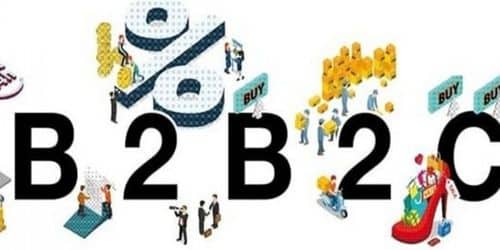Companies typically offer their goods and services either through the business-to-business (B2B) or business-to-consumer (B2C) model. Businesses are implementing a modern framework that mixes B2B and B2C selling models as e-commerce and remote selling gain popularity. Knowing this new selling ecology can help you grow your career in business management or e-commerce and make strategic judgments at work. In this post, we define the B2B2C selling model, list its benefits, provide examples, and explain how it works and how to apply it for companies.
What is B2B2C e-commerce?
B2B2C stands for business-to-business-to-consumer, and it is a business model in which two companies provide complementary items or services to the same end consumer. This corporate partnership is common between a company that provides products or services and a company that manages the client transaction – everything from customer support to orders, fulfillment, and shipping.
Many B2B2C models utilize online merchants and marketplaces, such as Amazon for physical items or app stores for software and digital tools. Partnerships between manufacturers and delivery service providers are other examples of B2B2C models.
The company that offers the whole B2B2C experience acts as a go-between for manufacturers and customers. This position enables brands to reach more people more efficiently, enhances the customer experience, and increases revenue for both companies. The B2B2C model also generates new business prospects for intermediary businesses and helps both sides expand their brands.
B2B2C has risen in popularity over the past several years as a result of significant changes in how people find products and services online. The ongoing increase in remote work and social distance problems highlight the need for this end-to-end model.
Comparison of the B2B2C Model To Other Models
The B2B2C model shares characteristics with other business models, but it’s critical to understand the differences so you can decide which is ideal for your company.
#1. B2B (Business-to-Business) Model
Business to business (B2B) is when one company develops resources, products, or services and sells them to another company. The term “ecosystem” refers to a group of people who work in the construction industry.
#2. Direct-to-consumer (D2C) and business-to-consumer (B2C) models.
B2C businesses, like grocery stores, are usually the middle link in a B2B2C chain from a manufacturer to the end user. B2C businesses were among the first to adopt e-commerce platforms and methods.
Yet, e-commerce has increased the popularity of direct-to-consumer (D2C) firms. In a direct-to-consumer (D2C) model, manufacturers and vendors sell directly to customers, bypassing the retailer. Internet marketplaces have made it easier for vendors to connect with end users directly.
#3. Channel partnerships
Channel partnerships are business relationships in which companies collaborate to produce a rebranded or white-labeled product. For example, a grocery shop that carries a certain brand of coffee may request that the manufacturer make additional products with a generic store-brand label.
Because both entail selling a brand’s goods through an intermediary, channel partnerships are quite similar to the B2B2C model. The main distinction is that B2B2C interactions do not conceal either of the firms involved. Customers are aware that they are purchasing a product manufactured by one company and supplied by another.
How B2B2C works
In a B2B2C model, the intermediate company sells a service to companies and items to consumers. For example, an online retailer such as Amazon provides its e-commerce shop hosting to other businesses as well as its speedy delivery services to clients that buy through their marketplace.
Depending on the industries of both companies, a B2B2C cooperation might operate in a few different ways.
- B2B2C Retail: A B2B2C company can buy another company’s products and resell them to clients through their own channels. The retailer is in charge of all aspects of order fulfillment and customer care.
- B2B2C service: A B2B2C company might function as a service provider for a shop, providing conveniences such as order fulfillment and shipping that the store does not generally offer. A common example is a third-party business that fills or delivers orders for restaurants and grocery stores. If the customer has any queries or reservations regarding their order, they contact the app’s customer support.
- B2B2C financing: Another common B2B2C solution is payment splitting services. B2B2C businesses handle the full transaction for a customer, including accepting multiple payment methods and executing the transaction. The B2B2C provider pays the manufacturer or merchant the complete amount, and the customer pays the B2B2C in installments.
Why are B2B Businesses Expanding to B2B2C?
Many B2B companies are moving to B2B2C for two reasons: remote work and scalability.
#1. Increase in Remote Work.
Many companies have switched to B2B2C due to the development of remote work after the COVID-19 epidemic. That is a trend that shows no signs of abating, as evidenced by this global study of CIOs.
Because so many clients work from home, their access to the market has shifted. While formerly considered a luxury, home-delivery services have increased dramatically in recent years, giving a potential commercial opportunity.
#2. Scalability.
Few B2B leaders can rapidly increase their operations without compromising service levels or overall sales effectiveness. As a result, rather than aiming to ‘be everything’ on their own, many B2B companies opt for collaboration and a B2B2C model to optimize commercial potential and achieve scalable growth.
For B2B2C to operate, both companies must target the same consumer base and give value that neither company could achieve on its own. Here are some examples of how the B2B2C model is advantageous to all parties involved:
- Company A: Quickly establishes brand credibility and taps into an existing client base for lower acquisition expenses.
- Company B: Provides a new or supplementary service without spending internal resources and collects more consumer data.
- Consumer: benefits from a convenient service provided by a reliable provider.
Does B2B2C Make Sense for All B2B E-commerce Businesses?
The distinctions between various company models are blurring.
According to McKinsey analysts, U.S. e-commerce penetration increased by ten years in three months, rising from a little over 15% at the end of 2019 to 35% at the end of Q1 2020.
While a brand manufacturer can now sell to everyone who asks online, this does not indicate that every sort of business will embrace the B2B2C model.
This is why:
#1. The B2B2C business model necessitates a certain amount of digital maturity.
The B2B2C business model is one that is frequently fueled by digitalization and the desire to sell online. It necessitates a strong commitment to implementing digital transformations and introducing new connectors to your online commerce infrastructure, not to mention e-commerce prioritization.
Not every retail business has made the transition yet.
#2. The product itself may be a constraint.
This business model is not appropriate for all products.
Direct sales to end users are not feasible for complex, regulated, or specialized products like medical or industrial equipment.
#3. You are not prepared to bargain.
B2B2C agreements can be difficult to sign if your company is unwilling to give them adequate credit, disclose consumer data, or provide reasonable pay.
Before getting into a corporate partnership, it is also vital to confirm that you are compatible with the other group. How will you be able to negotiate with them if they have different business priorities?
What Is a B2B2C Relationship?
Communication and compatibility between the two companies are essential to a successful B2B2C business relationship.
In this connection, one partner usually already has access to the consumer market, while the other wants to get access to it. Striking the correct balance in assisting the other to flourish is crucial to the long-term survival of the relationship.
This form of connection is frequently based on two primary characteristics:
#1. Immediate access to consumer data.
The incorporation of customer data might be beneficial to a company attempting to join a consumer market. The more information they have about the market and the consumers they want to attract, the better their chances of success.
If one of the businesses in this relationship is unwilling to exchange data, the partnership could lose steam very quickly.
#2. Brand Recognition.
Brand recognition is frequently the deciding factor between a sale and a missed opportunity.
One of the key reasons that B2B2C business connections emerge is due to brand recognition on the side of one of the companies. A company can enter the consumer market with an advantage over its rivals by using the brand familiarity of its partner.
B2B2C Drawbacks
The B2B2C eCommerce has both advantages and disadvantages to overcome, despite being relatively young and in high demand. Difficulties are present in any business model; yet, because of its relative novelty, B2B2C hasn’t yet had the time or widespread adoption required to inspire the inventive solutions offered to other models.
What Could Stop the B2B2C Strategy From Becoming Widely Used?
#1. Growing Demands
While B2B2C companies have more resources to meet rising customer demand, they nonetheless face the same difficulties as other companies: how can brands provide personalized, frictionless experiences without sacrificing return on investment (ROI)? This question leads some organizations to different eCommerce models, where they won’t have to take a risk on a relatively new technique.
#2. Complicated Partnerships
A B2B2C partnership involves more stakeholders than a standard B2B or B2C model. Companies must handle relationships with intermediaries as well as end customers, balancing partners’ needs with consumer expectations to create an efficient selling environment.
#3. Management of the Client Experience
As with any substantial change, converting to a B2B2C model demands companies reconsider their connection with consumers. When B2B2C brings a middleman into typical transactions, the principal brand must examine how this will affect the customer experience and whether a more hands-on management strategy is required.
#4. Investment Required
Changing from a B2B to a B2C business model necessitates an initial investment. This covers the price of a strong eCommerce platform capable of interacting with customers and integrating with external business solutions. It is also vital to invest in platforms capable of sharing consumer data between parties, allowing all stakeholders to be key players in the commerce ecosystem.
#5. Infrastructure Improvements
The third, and maybe most difficult, difficulty connected with B2B2C firms is the need to adapt or completely rethink the underlying infrastructure. When the business has been done in the same way for years, switching to anything new can be challenging, time-consuming, and even uncomfortable. Personnel roles, budgetary concerns, target audience, and other factors must vary as corporate goals do. In many respects, these changes might feel like a full redesign of the original firm — and that much change can be unsettling for people. Addressing these logistical and cultural barriers can prevent organizations from making the transition.
The term “ecosystem” refers to a group of people who work in the construction industry.
Under the B2B2C model, first B can participate in second B’s marketing activities, which are frequently held around national holidays and events but can also be customized (e.g., discounts on the birthday of every person in the client database). This also imposes obligations on first B to get well-prepared for sales events and create a sufficient stock of goods in their warehouse to meet the peak demand during such sales.
Marketing collaboration between sellers and the marketplace offers tremendous prospects that must be utilized flexibly and successfully. At the same time, sellers should not rely solely on the B2B2C model for sales and should build their own client base and customer communications in order to achieve a more stable market position.
Participating in collaborative marketing efforts including numerous sellers may be advantageous for a seller (supply, manufacturer). Sell anything in volume, for example — buy a case of beer from one vendor and a set of mugs for half the price from another. In other words, cross-selling marketing can be a very profitable sales tactic in B2B2C.
Examples of B2B2C eCommerce Platforms
Some examples of the B2B2C model include:
- Online Travel Agents: Consumers can purchase flights, hotels, and rental vehicles from various companies in a single transaction using online travel agents. Expedia and Travelocity are two examples of internet travel agencies.
- Online food ordering platforms: They enable customers to place orders from various restaurants in a single transaction. Seamless, Grubhub, DoorDash, and Uber Eats are examples of online meal-ordering platforms.
- Group Buying Platforms: allow customers to buy products and services at a discount. Groupon is the most well-known group purchasing site.
- Crowdfunding platforms: allow individuals to pool their funds to finance a project or product, typically in the small company sector. The most popular crowdfunding platform is Kickstarter.
Large markets, on the other hand, use multiple sales models in addition to the B2B2C model. For example, the B2B2B model is being applied since businesses may shop on Amazon alongside consumers. Curiously, consumers can also sell their items on such platforms; hence, C2B2C and C2B2B models are viable.
Consumers sell goods or services to other consumers or businesses through an online marketplace in C2B2C and C2B2B e-commerce. Thrift stores, which existed for at least a century before the advent of online commerce, and second-hand websites such as eBay, Craigslist, and OfferUp are early examples of the C2B2C model.
Visit UpWork to see an example of a C2B2B model. It is the largest freelance and crowdsourcing marketplace in the world. Companies offer projects, which freelancers bid on. Businesses select the best offers and award the project to the freelancer.
The major benefit of B2B2C is that it allows firms to reach a bigger network of purchasers than they could otherwise. This expands the market for their goods and services.
Top B2B2C Companies
B2B2C companies can be found in almost any industry, from manufacturing to art sales. The B2B2C model is used by the following eCommerce companies as examples:
- Amazon
- Alibaba
- Shopify
- App Store
- Google Play
They all provide goods or software created by other companies and sold directly to clients. Some industry examples include:
- Uber Ecosystem: When you order using the app (whether for food or a taxi), you are most likely ordering from a firm that has partnered with the platform.
- Even Financial: A financial platform working with big players like American Express to make it convenient for the end client to use any of the services of their partners.
- Airbnb: You do not order services directly through Airbnb; they provide the services of various tour operators.
Summary
Business-to-business (B2B) and business-to-consumer (B2C) are combined in the B2B2C model (B2C). Under the B2B2C model, one company employs another company to reach its customers. The B2B2C model differs from its commission-based monetization principle.
The term “ecosystem” refers to a group of people who work in the construction industry. B2B2C also produces an income stream for the second B firm and positions second B to present its clients with new and relevant products and/or services. As a result of “B’s” enhanced product and/or service diversification, the consumer client base also gains.
The B2B2C e-commerce model provides excellent prospects for business expansion and cost reductions for small manufacturers and startups. This is a strategy to increase sales, not only in local markets, but also in markets where second B operates.
The B2B2C model has proven to be effective for many firms, so it is definitely worth exploring if you are searching for an efficient approach to sell online.
- B2C MARKETING: Meaning, Example, and Strategies to Use
- B2C: What Is It, Difference & Advantages
- HOW TO GET INTO E-COMMERCE BUSINESS: The Complete 2023 Guide
- How to Start an Ecommerce Business From Scratch in 2023
- PROFITABLE E-COMMERCE BUSINESS IDEAS IN 2023






